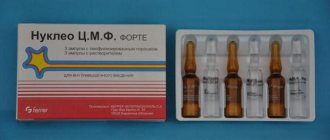Compound
GeloMyrtol® forte
| Enteric capsules | 1 caps. |
| active substance: | |
| myrtol standardized | 300 mg |
| for minimum content: | |
| limonene | 75 mg |
| cineola | 75 mg |
| α-pinene | 20 mg |
| excipients: rapeseed oil | |
| capsule: gelatin; glycerol 85%; sorbitol; hydrochloric acid solution 13% | |
| Enteric coating: hypromellose acetate succinate; triethyl acetate; sodium lauryl sulfate; talc; dextrin; ammonium glycyrrhizinate |
GeloMyrtol®
| Enteric capsules | 1 caps. |
| active substance: | |
| myrtol standardized | 120 mg |
| for minimum content: | |
| limonene | 30 mg |
| cineola | 30 mg |
| α-pinene | 8 mg |
| excipients: medium chain triglycerides | |
| capsule: gelatin; glycerol; sorbitol; hydrochloric acid 13% | |
| Enteric coating: hypromellose acetate succinate; triethyl acetate; sodium lauryl sulfate; talc; dextrin; ammonium glycyrrhizinate |
Pharmaceutical action
expectorant. Gelomyrtol contains as an active substance an essential oil of plant origin - standardized myrtol.
Myrtol standardized has secretomotor and secretolytic effects, which contribute to the liquefaction of sputum, activation of the mucociliary epithelium and, as a result, intensive production of sputum. When used in high doses, standardized myrtol also has antimicrobial, immunomodulatory, antispasmodic and vasodilatory effects.
Pharmacokinetics have not been studied.
Directions for use and doses
Orally, 30 minutes before meals, with a sufficient amount of water at room temperature.
GeloMyrtol® forte
Adults and children over 10 years old
Adults: for acute inflammation - 1 caps. 3–4 times a day; for chronic inflammation - 1 caps. 2 times a day; to facilitate sputum discharge in the morning - an additional 1 capsule. before bedtime.
Children from 10 to 18 years old: for acute inflammation - 1 caps. 2 times a day; for chronic inflammation - 1 caps. in a day.
The duration of treatment depends on the severity of the symptoms of the disease and is determined by the attending physician.
GeloMyrtol®
Adults and children over 6 years old
Adults: for acute inflammation - 2 caps. 4–5 times a day (8–10 capsules per day); for chronic inflammation - 2 caps. 3 times a day; to facilitate sputum discharge in the morning - an additional 2 caps. before bedtime (8 capsules per day).
Children from 6 to 10 years old: for acute inflammation - 1 caps. 3–4 times a day; for chronic inflammation - 1 caps. 2–3 times a day.
Children from 10 to 18 years old: for acute inflammation - 1 caps. 4–5 times a day; for chronic inflammation - 1 caps. 2–3 times a day.
The duration of treatment depends on the severity of the symptoms of the disease and is determined by the attending physician.
special instructions
If the symptoms of the disease do not disappear or the patient’s condition worsens, shortness of breath appears, body temperature rises, blood or pus appears in the sputum, you should immediately consult a doctor.
Patients with asthma or whooping cough should consult a doctor before using the drug.
During pregnancy and breastfeeding. Although there is no information about the negative effects of the drug Gelomirtol on the fetus, during pregnancy and lactation it is taken only under the supervision of a doctor, especially in the first trimester.
Children. Gelomirtol is used in children aged from 3 years, and Gelomirtol forte - from 6 years.
Influence on reaction speed when driving vehicles and working with other mechanisms. No data.
Note!
The description of the drug Gelomirtol on this page is a simplified author’s version of the apteka911 website, created on the basis of the instructions for use. Before purchasing or using the drug, you should consult your doctor and read the manufacturer's original instructions (attached to each package of the drug).
Information about the drug is provided for informational purposes only and should not be used as a guide to self-medication. Only a doctor can decide to prescribe the drug, as well as determine the dose and methods of its use.
Improving the tactics of drug treatment of patients with acute rhinosinusitis (ARS) continues to worry otolaryngologists, despite the large arsenal of pharmaceutical drugs at their disposal. This is due to the widespread and steady growth of this pathology, the difficulty of obtaining adequate material to establish the etiology of the disease, the growing resistance of pathogens due to irrational treatment and many other factors [1–4].
Currently, large-scale consensus documents have been created - EPOS-2007 and -2012, which analyze the entire world experience in the diagnosis and treatment of rhinosinusitis [1, 4]. As a result of the analysis, experts concluded that the symptoms of ARS in many cases are well eliminated with the use of antibiotics.
At the same time, given the fairly high effectiveness of placebo, one can expect good effectiveness from symptomatic therapy without the use of antibiotics, especially with regard to the mild form of ARS, the criteria for which in the EPOS recommendations are determined on the basis of a subjective assessment of the severity of symptoms using a visual analogue scale (0–10 cm):
- 0–3 – mild form;
- 4–7 – moderate severity;
- 8–10 – pronounced form.
Among the numerous groups of medications that are used in the treatment of patients with ARS, herbal medicines have become very popular among doctors and patients in the last decade, which is primarily due to their relative safety. Regarding the effectiveness of this treatment method, according to EPOS-2012 [4], in most existing studies, the active substance of herbal medicines is not standardized and, accordingly, the mechanism of its action from the standpoint of pharmacokinetics and pharmacodynamics is not clear. The relatively small array of randomized placebo-controlled trials of herbal medicines with an established mechanism of action of the active component is not representative for the evaluation of herbal medicine for ARS, which emphasizes the need for further research in this direction. One of the successful experiences with the use of herbal medicine in patients with ARS is reflected in the results of a double-blind, placebo-controlled, multicenter study with level of evidence Ib (evidence obtained in at least one randomized trial), in which standardized myrtol (MS; 300 mg, 4 capsules per day) was used within 6 ± 2 days). The study included 331 patients. Analysis of the results demonstrated significant differences in the sum of scores for the severity of clinical symptoms compared to the group receiving placebo. Moreover, the need for additional antibiotic use in the main group was 23% versus 40% in the placebo group [5]. These results made it possible to include myrtol standardized in the EPOS 2012 recommendations for the treatment of acute rhinosinusitis in adults (grade A recommendation, for viral and post-viral ARS) [6].
The pharmacodynamic profile of mucoactive drugs is usually considered in close relationship with their mucosecretolytic properties. While most mucoactive drugs have one specific mode of action, MS exhibits secretolytic, mucolytic and secretomotor properties. In addition, the drug has a noticeable anti-inflammatory effect, neutralizing aggressive oxygen free radicals and reducing the concentration of leukotrienes and prostaglandin E2. Antimicrobial properties have also been identified in MS, primarily against pathogens that are most often found in inflammatory diseases of the respiratory tract - Streptococcus pneumoniae and Haemophilus influenzae. Another advantage of this drug is the release form - the drugs GeloMyrtol® and GeloMyrtol® forte, containing standardized myrtol as an active substance, are offered in the form of enteric capsules, which leads to the release of the active substance only in the small intestine and significantly increases the bioavailability of MS, bringing it closer to 100%.
This distinguishes these drugs from the experimentally created form, which was absorbed in the stomach [7].
Thus, the pharmacokinetic and pharmacodynamic properties of the active substance, standardized myrtol, allow us to regard the drug not only as a means of versatile influence on mucociliary transport, but also as an effective antioxidant, as well as an anti-inflammatory and antibacterial agent.
Due to the presence of so many points of clinical application of MS, of great interest is the comparison of the effectiveness of GeloMyrtol®/GeloMyrtol® forte and other plant secretolytics, conducted in a prospective comparative study by Wittig T. (1998) with the participation of 569 patients with ARS, divided into 2 groups. Patients of group 1 (n = 284; 156 women, 128 men) received GeloMyrtol® forte; patients of group 2 (n = 285; 168 women, 117 men) received an alternative herbal secretolytic. The duration of treatment was about 2 weeks. A significantly higher effectiveness of GeloMyrtol® forte was noted in all forms of ARS compared to the comparison drug, which was effective only in mild forms of ARS. Among the clinical symptoms, the most pronounced differences were noted in the dynamics of pain when pressing on the area of the paranasal sinuses, which correlated with the data of the ultrasound picture when scanning them. The final efficacy, as assessed by patients, when using GeloMyrtol® forte was 95% versus 83% when treated with an alternative drug. The need to prescribe antibiotics in group 1 was lower than in group 2 (19.0% versus 23.9%) [8].
Material and methods
Taking into account the above, at the Department of Otorhinolaryngology of Moscow State Medical University named after. A.I. Evdokimov conducted an open controlled study of the effectiveness and tolerability of the drug GeloMyrtol® forte in the treatment of ARS and exacerbation of mild chronic rhinosinusitis (ACRS).
A preliminary (input) examination of patients in order to decide on the possibility of including them in the research program included the collection of complaints and medical history, assessment by the attending physician of subjective and objective data on the patient’s condition (standard ENT examination), X-ray examination, study of mucociliary transport using a saccharin test .
A control assessment of the patient’s condition was carried out on the 1st (1st visit), 3rd (2nd visit), 5th (3rd visit) and 7th day (4th visit) from the start of treatment (in the absence of cure at earlier stages). A control assessment of mucociliary transport was performed during the initial examination, during the second and fourth visits (in the absence of recovery by the third visit). X-ray examination of the paranasal sinuses was carried out before and after treatment (twice).
The study patients were randomized into two groups:
- Group 1: patients with ARS (n = 12) and ACRS (n = 18), who took GeloMyrtol® forte 1 capsule 3 times a day for 7 days. Average age – 34.76 ± 12.19 years; 15 men, 15 women.
- Group 2: patients with ARS (n = 12) and ACRS (n = 18), who took the herbal medicine Sinupret® 2 tablets 3 times a day for 7 days. Mean age 32.03 ± 7.43 years; 13 men, 17 women.
Research results
Before the start of therapy, the sum of the average values of general clinical symptoms of rhinosinusitis was the same in both groups. During the treatment, positive dynamics were noted in both groups, however, there were certain differences (see table).
When analyzing the results obtained, an effective reduction in a number of symptoms (headache, difficulty in nasal breathing, snoring, sneezing, discomfort in the nasal cavity) was noted during treatment in both groups: by more than 50% by the 2nd visit and by more than 70% from baseline to the 4th visit.
For other indicators, the results obtained in the study groups were statistically significantly different. Thus, discharge from the nasal cavity by the 2nd visit in the 1st group decreased by 52%, in the 2nd group - by 35% (p ≥ 0.05), and by the 3rd visit in the 1st group – by 75%, in the 2nd – by 50% (p ≤ 0.05). A significant difference between the groups remained at the 4th visit.
A similar picture was noted in the indicator of the presence of discharge on the posterior wall of the pharynx, which in the 1st group by the 2nd visit decreased by 57%, and in the 2nd group - by 46% (p ≥ 0.05). By the 3rd visit in the 1st group the decrease was already 83%, and in the 2nd group the indicator did not change, which made it possible to achieve statistical significance of the differences (p ≤ 0.05). This difference was persistently maintained by the 4th visit (see figure).
The dynamics of the decrease in radiological signs of rhinosinusitis was more pronounced in group 1, which by the end of the study was reflected in the achievement of statistical significance of the difference between the groups in this indicator (p ≤ 0.05).
During the study, a decrease in mucociliary clearance time was noted in both groups, and the data between them did not differ significantly (see figure).
In the 1st group of patients, on the 3rd day of observation, the need for correction of the treatment regimen appeared in 7 patients, which required additional prescription of a decongestant and antibiotic.
In group 2 there were 8 such patients, which required a similar adjustment of the prescribed treatment.
No adverse events were identified during the study in both groups.
conclusions
The drug GeloMirtol® forte can and should be used as monotherapy for ARS and acute acute respiratory syndrome of mild severity.
The results of the study confirm the high effectiveness of the drug GeloMyrtol® forte in the treatment of patients with mild rhinosinusitis, which exceeds that with monotherapy with the drug Sinupret® and is expressed in more rapid relief of cough, a decrease in the amount of discharge from the nasal cavity, a decrease in the sensation of mucus flowing down the back wall of the pharynx, and objectively – in reducing swelling of the nasal mucosa and the amount of pathological discharge.
The drug GeloMirtol® forte is well tolerated by patients and does not cause unwanted side effects.
The use of Gelo-Myrtol® forte made it possible to avoid additional treatment, including antibacterial therapy, in 77% of patients with ARS and ACRS.



